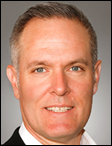Readers Write: CMS’s E-Notifications Condition of Participation: Three Topics to Know
CMS’s E-Notifications Condition of Participation: Three Topics to Know
By Jay Desai
Jay Desai, MBA is CEO and co-founder of PatientPing of Boston, MA.

In March 2020, the Centers for Medicare and Medicaid Services (CMS) finalized the new Interoperability and Patient Access Rule, which creates a new Condition of Participation (CoP) that requires hospitals, psychiatric hospitals, and Critical Access Hospitals to share electronic Admission, Discharge, Transfer (ADT) based event notifications (e-notifications) with other providers across the continuum of care whenever patients have inpatient or emergency department care events.
To help these organizations prepare for the e-notifications CoP, a recent hospital executive survey was conducted to gauge industry awareness about the regulation (the survey results can be found in an online e-book called “The Route to Compliance. A Simplified Pathway”). Responses from hospital CIOs and compliance executives collected through dozens of conversations, virtual focus groups, and webinars revealed three key areas that need more awareness.
#1: The Requirements
According to the survey, which was conducted in May and June of 2020, just 17% of hospital CIOs or compliance personnel are familiar with the e-notifications CoP. The goal of the new CoP is to increase information sharing across the care continuum as a way to enable better care coordination leading to improved patient outcomes. This compliance requirement will go into effect on May 1, 2021 and adds to the list of CoPs hospitals must fulfill to successfully maintain their CMS provider agreement and certification. The fact that CMS used its most consequential regulatory lever, a CoP, to create the new e-notification requirement underscores the importance the agency places on increasing provider access to needed information.
Hospitals should answer how they or their third party intermediary solution will comply with the following requirements:
- Identify and send e-notifications to post-acutes.
- Meet cross-regional provider notification needs.
- Ensure appropriate data sharing rights, security, and trust.
- Send notifications in real time.
- Manage continuous provider-patient relationship changes.
- Demonstrate compliance to meet survey requirements.
- Ensure community-based providers have excellent user experience.
- Meet compliance by the May 1, 2021 deadline.
#2: Provider-Requested Notifications
This topic is particularly important to health systems with large provider and post-acute referral networks. Hospitals must send e-notifications to community-based providers that have established care relationships with patients and that need the information for treatment, care coordination, or quality improvement activities. This includes primary care practitioners, Federally Qualified Health Centers, Accountable Care Organizations, other entities identified by the patient as primarily responsible for their care, and post-acute providers (skilled nursing facilities, home health agencies, etc.). Identifying which providers have established care relationships is critical and requires that hospitals, or their intermediary, possess two foundational capabilities:
- Ability to collect patient-identified provider information at the point of care.
- Ability to obtain care relationship information from providers through a patient roster and notification request process.
The first capability allows hospitals to determine any providers with whom the patient wants their information shared by giving patients the ability to identify providers at the point of care. The second capability allows hospitals or intermediaries to determine any additional practitioners, groups / entities, or post-acutes that need to receive notifications for treatment, care coordination, or quality improvement activities. The roster and notification request process allows providers to identify their care relationships through rosters, e.g. patient panels or census lists, and receive e-notifications based on hospital care events that match to patients on those rosters. Having both of these capabilities gives hospitals the ability to determine the required providers that need notifications thereby eliminating e-notification gaps that would lead to non-compliance.
#3: Health Information Exchanges (HIEs) as Intermediaries
Hospitals have the option to use an intermediary, such as an HIE or vendor, to fulfill the e-notification function under this CoP. In the survey cited above, 60% of respondents familiar with the rule somewhat agree with the statement, “that their local HIE will ensure 100% compliance with the CoP.” Just 17% fully agreed with that statement. Given that HIE capabilities vary widely by state and region, compliance will depend on whether the HIE can fulfill the minimum requirements specified within the final rule. Those requirements include:
- Event types and timing. Notifications must be sent at the time of patients’ inpatient admission, discharge, and transfer and at emergency department presentation and discharge.
- Notifications recipients. Established PCPs, practice groups / entities, and post-acutes irrespective of geographic location that request notifications for treatment care coordination, or quality improvement activities.Practitioners, practice groups / entities, and post-acutes irrespective of geographic location that are identified directly by patients as primarily responsible for their care.
- Notifications content. Notifications must include, at minimum, patient name, treating practitioner name, and sending institution name.
Notifications also need to be sent in accordance with patients’ privacy preferences and applicable federal and state laws and regulations. Additionally, to minimize security incidents and inaccurate notifications, a high accuracy match rate is needed to ensure notifications are sent to appropriate providers. Ultimately, hospitals are accountable to meet compliance requirements even when e-notification functions are delegated and they should therefore ensure all minimum compliance requirements are met.
Given the significance of the new e-notifications CoP, hospitals should take time to carefully assess and validate internal or third-party capabilities against the new requirements to ensure they can meet compliance by May 1, 2021. With the proper solutions in place, hospitals can share real-time patient data with other community providers to support treatment and care coordination efforts, bolster value-based care initiatives, and, most important, improve health outcomes for patients while achieving e-notifications CoP compliance.
















Re: Dr Z. Great story, but whatever happened to professional courtesy???